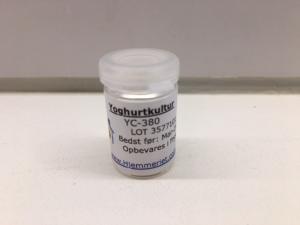Webshop
My page
 See Product Group See Product Group
|
Read more about Yogurt |
Add to cart
|
|
|
|
|
Starter culture with acidophillus and bifidobacterium for making probiotic yogurt.
Produces a nice fresh, silky smooth yogurt. Cultures within 12-20 hours depending on the desired level of acidity. Mature the freshly made yoghurt for 12 hours in the fridge for optimal development of flavours and texture. Yogurt made with high-fat milk makes the creamiest of yogurts.
If you prefer a thicker yogurt like greek, run your regular yogurt through a tight woven cheese cloth or use a yogurt strainer to drain off excess whey.
Conveniently bottled in a small glass vial with snap-cap, enabling you to take out small portions and reseal the vial to preserve freshness. Contains powder to make up to 25 liters of yogurt.
See our recipe for home-made yogurt here
|
Loading...
Content
Konsistens og smag af yoghurt fremstillet med forskellige kulturer
Bemærk at Contents: 1 g.
Other products with similar contents: - Hjemmeriet > Yogurt > Cultures > Thermophilic: Yogurt culture - ABY - Probiotic UsageThis starter culture ferments any dairy milk or vegetable milk like soy or coconut as long as is contains adequate amounts of sugars for the bacteria to thrive. It is also possible to make lactose-free soured milk products or yogurts from dairy. Learn how to make lactose free milk here.
DosageContents of 1 g is intended for 25 liter. This is a DVS culture. A starter culture is defined as either a DVS culture or a heirloom culture. A DVS culture is designed to give a unique flavors and texture every time. These cultures are called Direct Vat Set cultures or just DVS cultures. If a DSV culture was your base to make a batch and you use some of this as starter culture for your next batch, it could cause an undesireable shift in flavors and textures. This happens when the balance between bacterial strains shifts and may be noticable already after the second batch. It is not a problem to use this first batch as starter for the next but you may find flavors and textures hereafter alter too much. If this happens for you, make a fresh start using a DVS starter. A DVS culture starter makes up to 25 litres or 250 litres with some chance of reusing the freshly made product as starter culture for more batches. The amount of starter culture to add when making 1 liter is very little - just a few pinches. Store the remainder of the DVS culture in the freezer to retain its activity for many months. A heirloom culture is designed to make 1 portion of 1-1½ litres. The bacterial composition in a heirloom culture is in balance and only alters slightly from batch to batch, making them a good choice if you want to take out fresh portion as starter culture for the next batch. However, bare in mind, freshness is crucial for any starter culture and you may not always want to make new batches continuously. If so, simply freeze a small portion of the product for later use. Be aware; a defrosted product tend to be less active as starter culture and that poses a risk for changes in flavors and texture. In sum, each type (DVS vs. heirloom) approximately yields the same amount but a DVS culture is much more convienient if you wish to make a product on occasion and have a break in between batches. DVS cultures barely looses any freshness in the freezer compared to a heirloom culture. Our cultures come in 3 variations / sizes
Note om dosering af bakteriekulturer og enzymer
Storage and DurabilityStore in freezer (-18°C).
BackgroundWhat is yogurt? Yogurt as a beverage is thought to originate from Central Asia and the reason why you can sometimes hear it spoken of as “the Bulgarian’s drink”. It was not until the early 20th century yogurt became widely known throughout the world, when the Russian biologist Ilyich Mekhnikov popularized it as the means to a long healthy life. Yogurt and other fermented milk products develop by the act of a myriad of lactic acid bacteria, converting milk sugars (lactose) into lactic acid. As these bacteria increase in numbers and feast on sugars, lactic acid and acidity levels increases coherently and make it difficult for the proteins to stay in solution. The distance between these proteins will begin to shorten, and in doing so they will form bonds and tangle up in masses. This is how coagulation and the characteristic thickness develops in yogurt. Milk is usually pasteurized for the purpose of killing off naturally occurring bacteria - including the more desirable lactic acid bacteria - therefore, they must be re-introduced to pasteurized milk to enhance correct fermentation. Almost all milk is pasteurized today. Lactic acid bacteria in yogurt are thermophilic, meaning they are a group of heat-loving species that thrives ideally between 30°C to 45°C. The most common species in yogurts are Lactobacillus Bulgaricus, Streptococcus Thermophiles, Lactobacillus Lactis and Lactobacillus Helvetica. MiscellaneousAbout fermented milk (yogurt/junket/sour cream) For a fermented milk product to be traded as "yogurt" it must traditionally contain at least the two following bacterial species; Lactobacillus bulgaricus (or Lactobacillus delbrueckii subsp. bulgaricus) and Streptococcus termophilus (or Streptococcus salivarius subsp. thermophilus). Fermented milk products that do not contain these species can not be marketed as yogurts, even though they often have the same properties as yogurt, in terms of flavor, texture and purpose. They are therefore often referred to as yogurts anyway - hence we speak off all fermented milk products as yogurt. There is a vast variety of different starter cultures to choose from. All contain species of lactic acid bacteria and can be used with regular dairy milk or nut milks, such as soy or coconut milk. Yogurt is cherished world wide and as a consequence there is a wide variation in flavor, texture and what bacteria that has been used to ferment the milk. The type of starter culture to choose depends solely on personal preference for flavors and texture. Health benefits Fermented milk products are thought to have many health benefits as lactic acid bacteria play a great role in keeping our digestive tract healty. When we consume fermented milk products, some of these bacteria make it to the gut and colonize our digestive system. They help break down food and perform many other health services. When we lack healthy bacteria in our digestive system, we are unable to break down the food properly and our overall health and digestive health can be compromized. By having a healthy gut flora we will not only feel good in your digestive tract - we will also feel more energized and our overall health improves as we benefit from the activities performed by the healthy bacteria. Yogurt products with a high number of species are known as probiotics and are thought to be the healthiest. However, keep in mind it is not always a good idea to mix several starter culture to increase the probiotic content, as this may not get you great results in terms of flavor and texture. Different species have unique properties that could affect fermentation, flavor and texture. Some multiply at room temperature whilst other species prefer warmer temperatures, thus one will outnumber the other and some times throw the flavoring off. Each species of lactic acid bacteria is thought to have their own unique health benefits, however Hjemmeriet has not the professional basis for recommending cultures nor specific bacteria if you wish to targets specific health benefits. We recommend that you seek information through the Internet or a professional health care nutritionist with knowledge about the health benefits of lactic acid bacteria. Although our personal opinion is that it it the healthiest to consume a variation of different fermented milk products, made with different strains of bacteria. Thermophilic vs. Mesophilic lactic acid bacteria Lactic acid bacteria are either thermophilic or mesophilic. The term thermophilic means 'heat-loving'. These bacteria thrive best in warmer termperatures between 38-46°C which then must be provided for them to develop and fermentation to happen correctly. When making yogurt, 42°C is the optimal temperature. The yogurt starter culture is to be added to the luke warm milk and this temperature kept steady for appoximately 4-12 hours. This temperature can be maintained by using a yogurt maker, an oven, kept close to the stove, wrapped up under the bed sheets or in an insulated box. The most commonly know yogurts are Bulgarian, Greek and Acidophilus. The mesophilic lactic acid bacteria thrive around 20-25°C, and ferments just by being left on the kitchen work top for 12-24 hours. Junkets and sour creams falls under this category. Since the mesophilic cultures ferment at room temperature, these are somewhat easier to make but with the help of yogurt makers, ovens etc., the thermophilic cultures can be just as easy. Both types benefit equally in maturing another 12 hours in the frigde, this will enhance better flavors and textures. Homo - and hetero-fermenting bacterial strains The bacteria in yogurts convert sugars in milk (mainly lactose) into lactic acid (C3H6O3), thereby raising acidity levels in the milk. Simply because the sugars provide them with the energy they need to thrive and reproduce. Despite the fact that all species produce lactic acid, they differ in demand for certain conditions as they perform different activities. Some species produce lactic acid only - these are called homofermative. Yet, other species produce CO2 and flavoring substances (Acetyl, Acetaldehyde, and Ethanol) which is what flavors yogurt. These bacteria are called heterofermative. To accomplish nice balanced flavors and textures, the right blend of bacteria is crucial. DVS vs. Heirloom yogurt starter cultures DVS (Direct Vat Set) starter cultures are freeze dried (powder) cultures, ready to mix with milk and ferment your first batch. If you ensure good hygiene, a small portion of the fresh yogurt can be taken out and used to culture the next batch. This can be done only a few times, then the composition of bacteria would have changed so much you will have to start over with frieze dried starter culture. Fresh yogurts made from heirloom (reusable) starter cultures can be used repeatedly to culture the next batch. In theory, the composition of these cultures are such that they can be reproduced for an infinite number batches without altering the composition of bacteria. However, be aware of potential contamination from other bacteria and do not leave more than 4-5 days inbetween making new batches. Flavor The distinctive sour flavor in yogurts is due to the lactic acid bacteria activity. Flavors vary from slightly sour to distinct sharp acidic flavors. It highly depends on which bacteria you use to ferment, fermenting time and temperature. The longer it ferments the stonger the sourness. Acidity is measured in pH units. The lower the pH, the more acidic. Fresh milk is about pH 6.8 but long fermentation time could develop pH leves around 4. Texture Yogurt can vary greatly in terms of thickness and texture. Depending on which starter culture you choose, what type of milk and how you ferment it - this will influence the texture. The thinnest yogurt is "piimä". If piimä is made based on cream the result will be only slightly thickened yogurt and still be consumed with a straw. At the opposite end of the scale you will find Greek yogurts, sometimes with a thickness like mashed potatoes. Yogurt can be grainy, stringy, creamy or gelatinous, it all depends on the cultures and how it is fermented. Why does yogurt turn thick in texture? In regular milk, the proteins are organized in clusters (micelles) which have a small electric (negative) charge. When two micelles collide in the fresh milk they will therefore repel from each other and will be evenly distributed in the milk. When milk ferments, sugars are converted into lactic acid that are electrically positively charged. This interferes with the protein's movement as they are slightly negatively charged. The consequence is that the micelles will be more bound to their present position which will result in a thickening of the milk (liquid). If you like thicker yogurts, heat the milk to 85°C prior to adding your culture, maintain this temperature for up to 30 minutes and cool the milk before adding culture and begin fermenting. This will affect proteins by hydrolyzation and thickens yogurt. If you like even thicker texture, once fermentation is complete, drain of excess whey using a strainer, a colander lined with a cheese cloth or anything else suitable. It is a good idea to let it drain off while standing in the refrigerator to minimize the risk of contamination from unwanted bacteria. Fresh cheese is drained yogurt... Straining fresh yogurt produces a from of "Fresh Cheese". Remove excess whey as described above or you can also add a bit of rennet to thicken it. By adding a few drops of rennet, the proteins will tangle up in the presence of Calcium and cause a thickening. The whey will effortlessly separate from the proteins and easily be poured off. DocumentsFor additional information - please see the following links: For additional information - please see the following links:Culture OverviewUse the following to understand your possibilities for choosing cultures and enzymes for the production of butter, soured milk or cream, yogurt and cheese. Read the introductory explanations first. This explains the basics you need to understand the range of possibilities. Read this firstTo make dairy products you typically need starter cultures and eventually enzymes and ripening cultures.
Bacteria strains used in starter cultures are classified based on their temperature for optimal growth: A mesophilic starter culture contains mesophilic bacteria strains only. In addition to the mesophilic/thermophilic classification, bacteria strains are divided into classes (O, D, L, T, Y, A and B), depending on specific properties of the bacteria strains. The O, D and L classes are mesophilic. The T, Y, A and B classes are thermophilic. The starter culture tables show which bacteria strains each starter culture includes. Additional information is available for the starter cultures:
The starter cultures contain blends of bacteria strains depending on the style of the dairy product being made. Some of the cultures are shown to contain the same strains of bacteria; however, those cultures are not identical. They each have a different ratio, percentage or contains individual sub-spieces of strains in order to give the desired result. Bacteria strains from class D and L are heterofermentive and will produce lactic acid along with CO2 (gas) and diacetyl and/or other components which will contribute a buttery taste. All other acidifying classes are homofermentive, producing only lactid acid and will contribute a more simple acidic taste. For ripening cultures, proteolysis specifies in which degree the microorganisms breaks down the milk proteins, which contribute to the development of flavour and texture of the product. Lipolysis specifies in which degree the microorganisms breaks down the milk fats, thereby contributing to the development of fatty acid flavour and texture of the product. Suggestions on startersLoading... Culture overviewLoading... MicroorganismsLoading... TipsOm konsistensJo længere tid yoghurten syrnes, des mere tykflydende bliver den og des mere smag vil den tillige opnå. Herunder ses et diagram, som illustrerer effekten af varmebehandling af mælk inden syrning, De farvede områder (1 – 5) afgrænser effekten af varmebehandlingen. Bemærk: Ændringen i viskositet ved varmebehandling skyldes påvirkning af mælkens valleproteiner. Diagrammet viser, er det mere er tiden end temperaturen, der giver en øget viskositet. Maksimal viskositet opnås ved varmebehandling i 17 minutter ved 87°C. En nem måde at håndtere varmebehandlingen på er, at opvarme mælken til 85-90°C, slukke for varmen og lade gryden stå i f.eks. 10 minutter, inden gryden sættes i vandbad for hurtig afkøling til 42°C. Diagrammet er kun vejledende og er udarbejdet på basis af tilgængeligt materiale fra
FactsCurrent storage information:
|
|||||||||||||||||||||||||||||||||||||||||||||||||||||||||||||||||||||||||||||||||||||||||||||||||||||||||||||||||||||||||||||||||||||||||||||
|
|


















































































































































































 In stock
In stock 

 Learn how to make your own home-made yogurt
Learn how to make your own home-made yogurt
 3/10
- Visitors: 1502207 - 1
3/10
- Visitors: 1502207 - 1